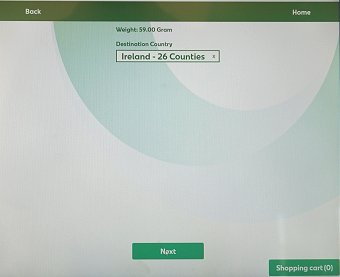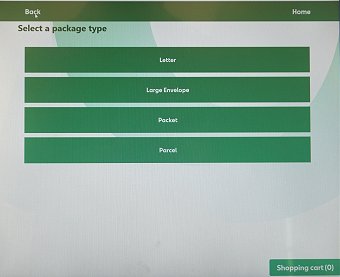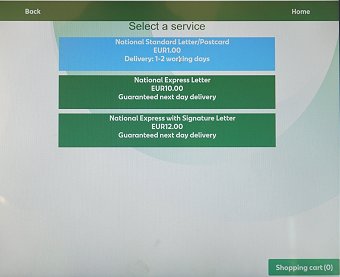| IRELAND (Éire). The SOAR issues in 2019 |
|
 |
| 19031, 'A History of Ireland in 100 Objects, a selection' (3rd part) |
In 2019 the An Post Philatelic Bureau released the third part of the ninth definitive stamp series 'A History of Ireland in 100 objects'. This great series was launched in 2017 and features a wide selection of objects relating to the history of the country (see article and also article, published in VARIABLE 44 and 48).
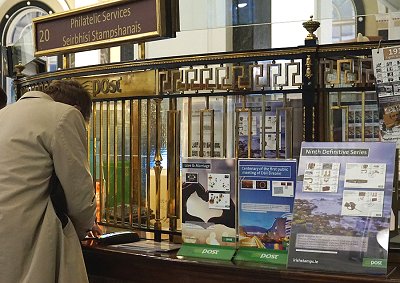 |
As on previous occasions, the set sold by the philatelic service consists of eight designs produced as SOAR (Stamps On A Roll) stamps. The new issue was available from January 31st 2019 (19031 is the ordinal date, in the format YYDDD - 19 for the year, and 031 the number of the day, starting with January 1st as day 1).
However, and for the first time since the beginning of SOAR stamps neither the Dublin GPO nor any other post office in the country had rolls with the new designs, on the first day of issue. |
| Variable rate stamps - ATMs |
Pre-printed stamps |
 |
 |
|
1. Rinnagan Crucifixion Plaque, 8th/9th Century
2. Slave chain, late 9th or early 10th Century
3. Clonmacnoise Crozier, 11th Century
4. Salamander Pendant, c. 1588 |
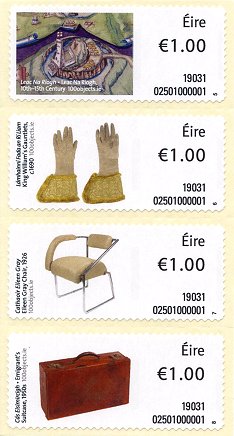 |
|
5. Leac Na Riogh, 10th-15th Century
6. King William's Gauntlets, c. 1690
7. Eileen Gray Chair, 1926
8. Emigrant's Suitcase, 1950s |
 |
|
Eventually, in mid-February, some branches started receiving and using the new series, but the rolls supplied included an unexpected surprise. In addition to the eight new designs, the reels also included seven of the eight designs of the second series issued in 2018, with images dedicated to Irish life and culture (see article, also published in VARIABLE 50), plus a new design not previously included in any SOAR series. The 16 designs are repeated successively in sequence throughout the 600 labels of each roll.
In the second series of eight images, the new design replaces the sixth image of the original series (right strip), which showed the Clerke shop front, in Skibbereen, in County Cork.
The new design, featuring a painting by Thomas Ryan, commemorates the centenary of the first public meeting of the Parliament or Assembly of Ireland, the Dáil Éireann, held on January 21st 1919 at Mansion House, in Dublin. Although some members were in prison following the 1916 Easter Rising, the parliamentarians declared Irish independence, ratifying the Proclamation of the Irish Republic issued in 1916, and adopted a provisional constitution.
The same image also appears on one of the two 'traditional' stamps that make up the centenary commemorative set, issued on January 17th 2019.
|
 |
| |
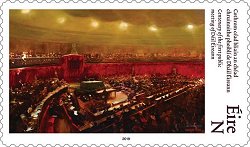 |
Therefore, the series has been printed in two different formats.
On the one hand, the Philatelic Bureau sells sets produced as two strips of four self-adhesive stamps with the eight new designs only and with all the information preprinted by offset digital (HP Indigo). The information in the right-hand block is identical on all stamps and the same on all the SOAR issues i.e. - The unique face value (1.00 EUR - current basic rate for domestic mail - see the table below), the date of issue (19031 - the first day of issue), and the 11-digit code below (02501000001). Only the upright numbering at the right hand edge is different for each design, going from 1 to 8. These stamps were also used on the pictorial first day covers (image below).
 |
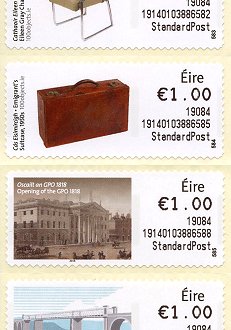 |
|
On the other hand, the series has also been printed in rolls of 600 self-adhesive labels, with 16 consecutive designs, with the pre-printed design, the country name - 'Éire', and upright sequential numbers (going from 1 to 600) in the lower right-hand corner. These rolls are used for the printing of variable value stamps in post offices equipped with the SOAR system.
In post offices, the printing is made using an Epson TM-J7500 thermal printer. In addition to the face value there is the date of purchase in ordinal format, and a unique identifier code for each stamp. The system can also include text indicating the shipment type (i.e. StandardPost - left image, RegisteredPost, ExpressPost, ExpressPost w/Sig, etc.).
The manufacturer of the rolls of labels is CCL Label Ireland Ltd., with identical characteristic to the earlier series. The labels were designed by Zinc Design Consultants. |
 |
Dated between late 9th and early 11th centuries, the Clonmacnoise or Prosperous Crozier was used as an ecclesiastical staff of office. It is a great example of medieval crafts, and is one of the oldest and best-preserved complete croziers in Western Europe. |
| |
Original series
(August 2018) |
Variety 1
(February 2019) |
Variety 2
(May 2019) |
|
|
 |
 |
 |
|
A few months after the first variety of this series (see article, published in VARIABLE 52), An Post again decided to modify the set of 16 designs on the reels of labels used for the printing of variable value stamps in post offices equipped with the SOAR system.
This modification by An Post consisted of replacing the last design of the original series, dedicated to surfing at the Wild Atlantic Way, with one promoting organ donation. This design was first issued as a 'traditional' stamp, in March 21st 2019 (image below). |
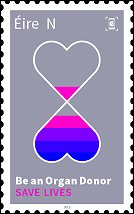 |
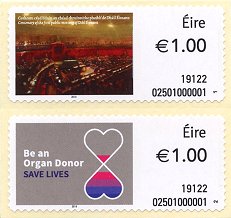 |
|
All these changes are decided directly by the Irish postal administration using its own criteria and without any input from the philatelic department. This means that these changes and new designs have no 'official' first day of issue, nor have any special postmarks been prepared for them. The philatelic bureau recorded these changes by producing strips of two preprinted stamps for domestic mail with the two new designs, the first introduced in the original SOAR series -100 years of the Dáil Éireann and the second being the "organ donation" design-, numbered 1 & 2, and both dated 19122, May 2nd 2019. |
| 2019. New post offices, new postal kiosks ... new stamps! |
At the beginning of 2018, An Post launched a study in order to identify the current challenges facing the company and to establish the context for the creation and development of a sustainable network of post offices in Ireland. Like other European postal administrations, An Post's post office network is facing an uncertain future, with the number of transactions decreasing, increasing competition from the use of new technologies, and the changes in consumer habits.
| The company's ambitious transformation program aims to modernize its post offices and services, enabling the change from an old business model based on mail deliveries and cash transactions to the new digital world of electronic commerce and financial services. In short, this means more modern and accessible offices, equipped with technologies that provide a better service and, of course, as is usual in these transformation initiatives the rebranding of the company with a new corporate image. |
|
 |
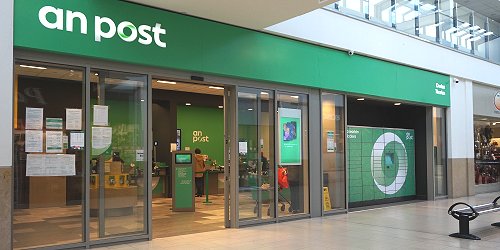 |
|
The first of these new post offices was opened on September 15th 2019 in Thurles, a small town in County Tipperary, in the south-central part of the country. This happened not without some controversy, since An Post decided to close the city center office and reopen it in a shopping center on the outskirts of the town, with thousands of locals protesting against this relocation.
However, the new post office, with the same long opening hours as the shopping center, allows better accessibility and offers new services, such as the parcel station and directly related to our field of study, a new postal kiosk. |
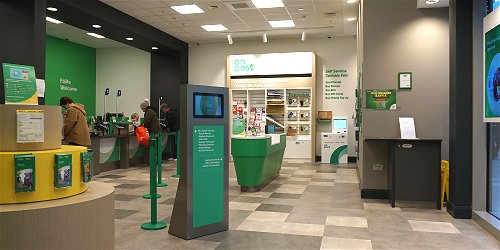 |
|
Indeed, after a not too successful experience with the Postal Service Centers equipped with Wincor Nixdorf postal kiosks, (installed from 2008 and in operation until 2015) (see article, published in VARIABLE 10), An Post decided to reintroduce postal kiosks in its post offices.
The self-service kiosks selected have been developed by the Integrex and Escher Group. These are the same machines installed by Jersey Post, in mid-2015, at the Broad Street main post office in St Helier (article and VARIABLE 38), and also by Qatar Post in 2018 in Doha main post office and branches throughout the country (article and VARIABLE 52).
The kiosk has a simple and compact design, with a touch screen, a small set of scales on the left, and a card payment unit which is the only payment option available, and which also includes a contactless device.
 |
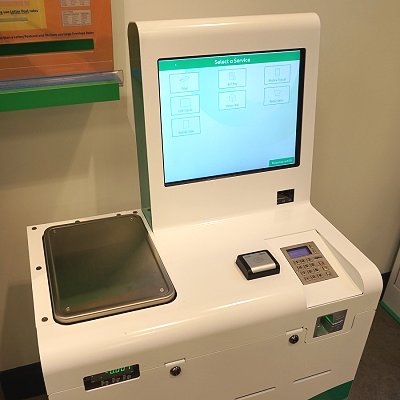 |
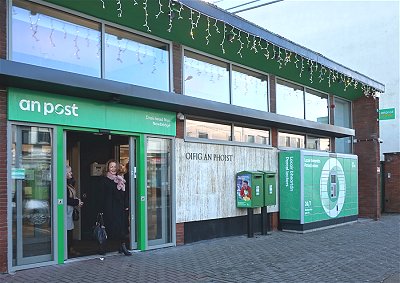 |
|
The second post office opened a few weeks later, on October 31st 2019, in Newbridge, in County Kildare, southwest of Dublin. This is not a new post office, but An Post decided to completely refurbish the existing office, installing a new parcel station at the front of the office building, and three (!) new postal kiosks inside (images).
Following Thurles and Newbridge, An Post plans to continue the complete refurbishment of St. Andrew's street post office in Dublin, as well as the Limerick and Cork post offices, to be followed by several other branches across the country. In some recently renovated offices, such as the one in the Pavilion shopping center in Swords, An Post has planned to install new signage and equipment, such as the new postal kiosks and / or parcel stations. |
 |
|
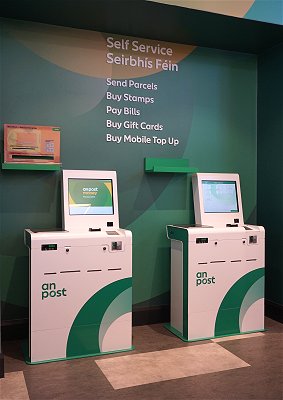 |
|
In Newbridge, two of the kiosks are installed in a self-service area, along with a cash machine and a parcel mailbox. The third machine (image above and below) is next to the counters, and in addition has a parcel mailbox nearby. |
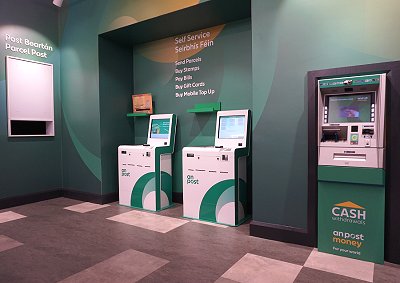 |
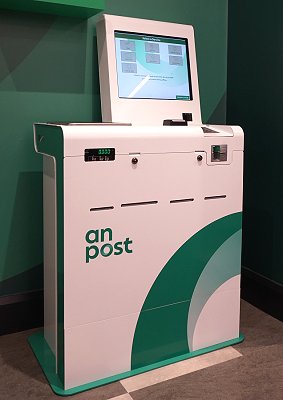 |
|
In line with the guidelines established by An Post, the new postal kiosks offer the direct purchase of stamps with several programmed face values ('Stamp Sale' option in the main menu) and the mailing of letters and packets according to their weight and delivery type ('Mail'). The machines also offer other services, which may be extended in the future.
|
 |
In addition to the two outlined options, the main menu (screen below) enables customers to pay bills, recharge mobile phones, purchase gift cards, return parcels, and even purchase items for sale at the post office using product bar codes.
During the first months of the postal kiosk pilot test, the 'Stamp Sale' option (screens below) enabled the purchase of stamps with only two face values, 1.00 and 1.70 EUR, corresponding to the current postage rates for domestic and international letters up to 100g.
After payment, the machine issues the stamps and a receipt printed on low-quality thermal paper.
|
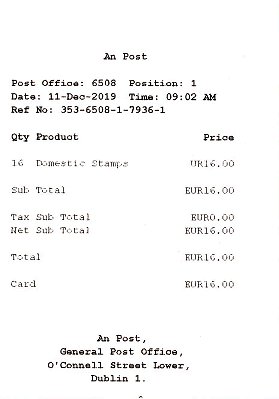 |
 |
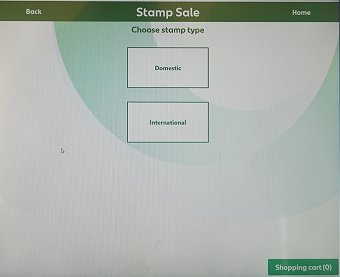 |
 |
 |
 |
|
During this first phase, all the kiosks in service used rolls of labels with the same sequence of 16 designs (variety 3 - see previous article) used by the SOAR equipment installed at the counters, although in rolls of 2,000 labels to minimize maintenance operations.
As can be seen in the images, the imprint produced by the kiosks with the 'Stamp Sale' option is totally different to that of the computer system installed at the counters. The machine and stamp numbers are printed under the face value. Unlike the variable value stamps issued by the SOAR system, these stamps do not include the date of purchase. When buying more than one stamp, the kiosk issues the stamps in strips.
The machine code 35365081 (images) corresponds to the kiosk installed in Thurles post office. Codes 35365051 (strips below), 35365061 & 35365071 are the three Newbridge machines. 35365151 corresponds to the kiosk installed in Swords. |
 |
 |
|
Selecting the 'Mail' option (sequence of screens below), the machine requests the user to place the postal item on the scales, and to key the size and the shipping type required. During the first months of operation, this option was available for domestic mail only. For domestic letters and postcards posted by standard mail, the system issues a variable value stamp similar to the previous one, with the face value, machine and stamp numbers, but - as can be seen in the images - the printing font used for the face value is totally different, smaller and in bold.
Unlike the previous 'Stamp Sale' purchase option, stamps issued with the 'Mail' option must be added to the shopping cart individually, and the kiosk also issues them as single guillotined stamps.
During the first weeks of operation, all the installed kiosks had frequent breakdowns and many problems with the stamp printing and cutting process. |
| The same purchase option, issues stamps for express mail on larger white, self-adhesive thermal labels with a barcode, but without a face value. |
|
 |
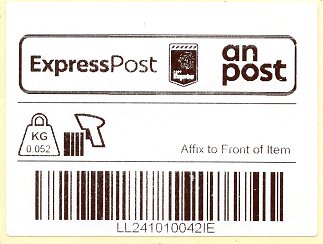 |
(to be continued ...)
| The basic postal tariffs in Ireland (2008 - ...) |
| Ireland and North Ireland |
Great Britain |
Europe |
Rest of the world |
Letter / postcard
Up to 50 g |
Letter / postcard
50-100 g |
Large envelope
Up to 100 g |
Letter / postcard
Up to 50 g |
Letter / postcard
50-100 g |
Large envelope
Up to 100 g |
Letter / postcard
Up to 50 g |
Letter / postcard
50-100 g |
Large envelope
Up to 100 g |
Letter / postcard
Up to 50 g |
Letter / postcard
50-100 g |
Large envelope
Up to 100 g |
| 3.03.2008 |
| 0.55 |
0.55 |
0.95 |
0.82 |
0.82 |
1.50 |
0.82 |
0.82 |
1.50 |
0.82 |
0.82 |
1.50 |
| From May 1st 2012 |
| 0.55 |
0.65 |
0.95 |
0.82 |
0.90 |
1.50 |
0.82 |
0.90 |
1.50 |
0.82 |
0.90 |
1.50 |
| Up to 100 g |
Ireland and North Ireland |
Great Britain |
Europe |
Rest of the world |
| Letter / postcard |
Large envelope |
Letter / postcard |
Large envelope |
Letter / postcard |
Large envelope |
Letter / postcard |
Large envelope |
| 2.04.2013 |
0.60 |
1.05 |
0.90 |
1.65 |
0.90 |
1.65 |
0.90 |
1.65 |
| 21.07.2014 |
0.68 |
1.20 |
1.00 |
1.95 |
1.00 |
1.95 |
1.00 |
1.95 |
| 1.07.2015 |
0.70 |
1.25 |
1.05 |
2.05 |
1.05 |
2.05 |
1.05 |
2.05 |
| 21.07.2016 |
0.72 |
1.30 |
1.10 |
2.15 |
1.10 |
2.15 |
1.10 |
2.15 |
| 13.04.2017 |
1.00 |
1.65 |
1.35 |
2.50 |
1.35 |
2.50 |
1.35 |
2.50 |
| 4.04.2018 |
1.00 |
1.80 |
1.50 |
2.80 |
1.50 |
2.80 |
1.50 |
2.80 |
| 25.02.2019 |
1.00 |
2.00 |
1.70 |
2.90 |
1.70 |
2.90 |
1.70 |
2.90 |
| 19.03.2020 |
1.10 |
2.00 |
1.80 |
2.90 |
1.80 |
2.90 |
1.80 |
2.90 |
ATM Web - Spain and Latin American Postal Services: http://www.ateeme.net
© J. Jove - ATEEME. Variable value stamps study group. All rights reserved
This page was created in April 2019 and last updated:
06.05.20
. English edition last rewritten by J. Gareze (6.05.2020)
|



































